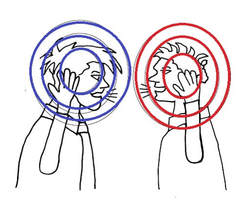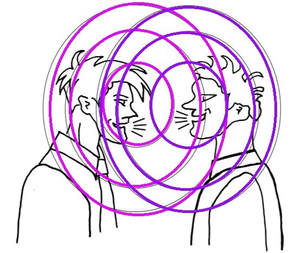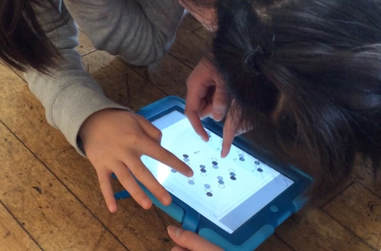Dialogic means seeing things (or feeling things or thinking things) from at least two points of view at once. Monologic means only acknowledging one correct point of view as if everything was visible all at once laid out flat on a table in front of us. It is only through entering into dialogue that ideas change and new perspectives can be taken on board. To enter into dialogue with each other ideas need to move into a shared space where they can resonate together, merge in some ways, clash in others and stimulate the emergence of new ideas. This shared space of mutual resonance is ‘dialogic space’ and without it there is no real dialogue and no real learning.
In a similar way Buber contrasts the objectifying ‘I-it’ attitude that turns the other into an object with the intersubjectivity of the ‘i-thou’ attitude that engages responsively with the subjectivity of the other. The ‘I-thou’ attitude leads to entanglement which Buber characterises with a spatial metaphor, the space between or simply ‘the Between’ or ‘Zwischen’ (1958).
Buber extends the apparent inter-subjectivity of the I-thou relation to include relationships with non-human objects such as trees. This extension of dialogic relationships beyond human voices is also found in Bakhtin who remarked ‘I hear voices in everything’. It is essential to dialogic educational theory that we realise that the dialogic space is not only inhabited by the voices of physically present humans. In education the dialogic relationship from which we learn the most is often with a disembodied cultural voice. This might be a dialogue with someone like Shakespeare, for example, or with an area of discourse such as Mathematics. In each case Shakespeare or Mathematics could appear external and static, if the education is not dialogic, or, with a more dialogic education approach, they could dynamically enter inside a learner to become a living voice that helps the learner understand new things.
The idea of dialogic space was perhaps first introduced into the analysis of classroom talk when I was writing and thinking together with Neil Mercer about how to explain effective collaborative learning in small groups (Wegerif and Mercer, 1997). The issue at the time was how to understand social cognition in the way in which the upper primary children (aged 8 to 11) were talking together in small groups. There seemed to be at least three significant types of talk, disputational talk when children disagreed with each other without giving reasons, cumulative talk when they agreed without reasons and ‘exploratory talk’ where they genuinely engaged with each other’s ideas. We realised that each type of talk reflected an intersubjective orientation related to a form of individual identification.
In disputational talk children identified with their own self-image or ego and each wanted to be the one to win the game and get the answer and in cumulative talk children identified with their image of the group as a harmonious unit and so did hot want to criticise. This seemed clear but then we asked ourselves, what is the form of identification involved with ‘exploratory talk’? A key feature of exploratory talk is being able to change one’s mind. The question then was, from what position is it that individual children are able to look at what they have said, find it wrong and so change their minds? This way of thinking about this practical issue led me to introduce the idea of identification with a ‘space of dialogue’ or ‘dialogic space’.
While Buber’s ‘Between’ is always a highly abstract notion, 'dialogic space' has a concrete aspect. This was seen recently in a primary classroom in Japan where a group of three upper primary children were arguing about a puzzle presented on a tablet. Not only did their body language converge on this central focus but so did their fingers. Each put a finger on the tablet to point out what they thought the key to solving the puzzle was. Pretty soon it was clear that much of the shared thinking was being done by their fingers (research by Taro Fujita – in preparation to be published, similar to Wegerif et al referenced below).
Dialogues cannot be defined only in terms of the external surface of things: they cannot be reduced to visible countable things as if they were just so many words or bits of data. Wherever dialogue occurs it opens up a space of multiplicity and uncertainty - a dialogic space which consists of resonances between utterances and voices. The opening of this space is the precondition for the possibility of learning something new. To try to define dialogues in terms only of the external and the visible is to try to kill precisely what makes them not only useful but essential to education - the internal and invisible dialogic space that makes new connections, new insights and new understandings possible. That is why we need a concept of dialogic space in education and in educational research.
Bakhtin, M. (1981). Discourse in the novel. In M. M. Bakhtin (Ed.), The dialogic Imagination. Four essays by M.M. Bakhtin. Austin: University of Texas Press.
Buber, M. (1958). I and Thou (2nd ed., R. Gregory Smith, Trans.), Edinburgh: T. and T. Clark.
Rommetveit, R. (1992). Outlines of a dialogically based social–cognitive approach to human cognition and communication. In A. Wold (Ed.), The dialogical alternative: Towards a theory of language and mind. (pp. 19–45). Oslo: Scandanavian Press.
Wegerif, R., & Mercer, N. (1997). A dialogical framework for investigating talk. In R. Wegerif, & P. Scrimshaw (Eds.), Computers and talk in the primary
classroom (pp. 49–65). Clevedon: Multilingual Matters.
Wegerif, R., Fujita, T., Doney, J., Linares, J. P., Richards, A., & Van Rhyn, C. (2017). Developing and trialing a measure of group thinking. Learning and Instruction, 48, 40-50.






 RSS Feed
RSS Feed